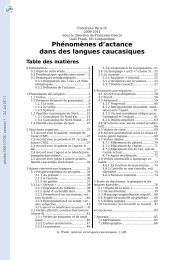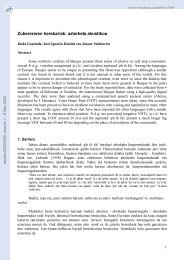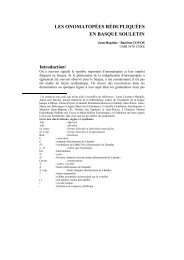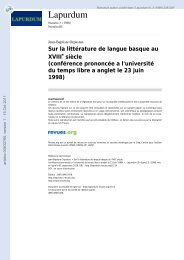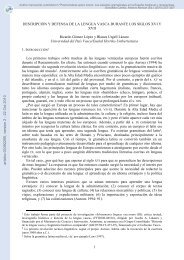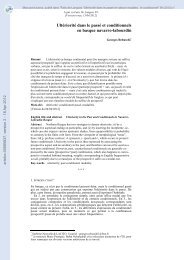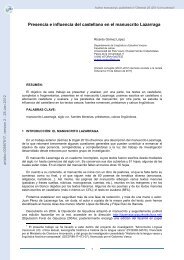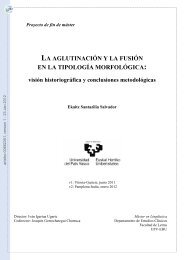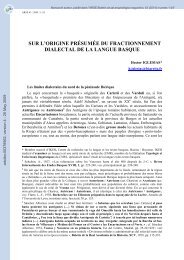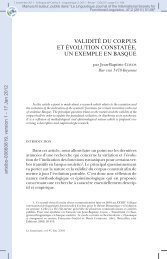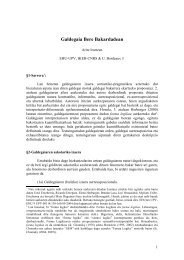On the polysemy of the suffike-ke in the history of Northern Basque
On the polysemy of the suffike-ke in the history of Northern Basque
On the polysemy of the suffike-ke in the history of Northern Basque
You also want an ePaper? Increase the reach of your titles
YUMPU automatically turns print PDFs into web optimized ePapers that Google loves.
artxibo-00494270, version 1 - 22 Jun 2010<br />
468 GEORGES REBUSCHI<br />
riority with respect to <strong>the</strong> reference po<strong>in</strong>t R provided implicitly or explicitly by <strong>the</strong><br />
protasis, 16 whereas -<strong>ke</strong> <strong>in</strong> <strong>the</strong> auxiliary marks a special type <strong>of</strong> assertion, express<strong>in</strong>g<br />
a logical prediction made by <strong>the</strong> spea<strong>ke</strong>r (prediction, and <strong>the</strong> expression <strong>of</strong> (high)<br />
probability, although <strong>in</strong>tuitively very proximate, are dist<strong>in</strong>ct psychological attitudes,<br />
even if formal semanticists almost never consider prediction as a special subtype <strong>of</strong><br />
modality). We shall see ano<strong>the</strong>r association <strong>of</strong> <strong>the</strong> prospective end<strong>in</strong>g on <strong>the</strong> lexical<br />
verb and <strong>the</strong> affixation <strong>of</strong> -<strong>ke</strong> on <strong>the</strong> auxiliary <strong>in</strong> section 11.<br />
5. The second analytic conjugation and <strong>the</strong> aoristic (defective) auxiliaries<br />
Let us now consider two defective verbs, which can only be used as (<strong>in</strong>flected)<br />
auxiliaries <strong>in</strong> certa<strong>in</strong> compound tenses, and whose reconstructed forms are °ed<strong>in</strong><br />
(used with unaccusative verbs, root -a(d)i-) and °ezan (with unergative and transitive<br />
verbs, root -eza-). 17 They will be noted aux2 below. A specific property <strong>of</strong> <strong>the</strong>se pure<br />
auxiliaries is that <strong>the</strong>y do not comb<strong>in</strong>e with any <strong>of</strong> <strong>the</strong> aspectually mar<strong>ke</strong>d participles,<br />
but with <strong>the</strong> radical <strong>of</strong> <strong>the</strong> lexical verbs. 18<br />
Stick<strong>in</strong>g to <strong>the</strong> unmar<strong>ke</strong>d present tense for <strong>the</strong> time be<strong>in</strong>g, and choos<strong>in</strong>g verbs <strong>in</strong><br />
which <strong>the</strong> radical is dist<strong>in</strong>ct from <strong>the</strong> perfective participle, we thus do not only have<br />
three dist<strong>in</strong>ct analytic comb<strong>in</strong>ations (as suggested by (1) above), but four:<br />
(6) a ekar.tzen du ‘he br<strong>in</strong>gs it’, lit. ‘carry<strong>in</strong>g he-has-it’<br />
b ekarr.i du ‘he has brought it’, lit. ‘carried he-has-it’<br />
c ekarr.iko du ‘he’ll br<strong>in</strong>g it’, lit. ‘to-carry he-has-it’<br />
d ekar °deza 19<br />
Here aga<strong>in</strong> appears <strong>the</strong> symbol ‘°’, and no translation can be directly provided.<br />
This is because, li<strong>ke</strong> <strong>the</strong> forms <strong>of</strong> <strong>the</strong> °n<strong>in</strong>doa type, but now even <strong>in</strong> <strong>the</strong> present<br />
tense, an affix is compulsory for an aux 2 to be licit - and <strong>the</strong> verb complex to be <strong>in</strong>terpretable.<br />
Until <strong>the</strong> end <strong>of</strong> <strong>the</strong> 17th century, 20 at least <strong>in</strong> <strong>the</strong> eastermost varieties <strong>of</strong> Nor<strong>the</strong>rn<br />
<strong>Basque</strong>, <strong>the</strong> past suffix -(e)n (with z- replac<strong>in</strong>g <strong>the</strong> present tense prefix d- <strong>of</strong> °deza<br />
above) was sufficient to license <strong>the</strong> forms, cf.:<br />
16 Hence a «future tense» when <strong>the</strong> auxiliary is <strong>in</strong> <strong>the</strong> present tense, i.e. when Speech Time and <strong>the</strong><br />
Reference Po<strong>in</strong>t ei<strong>the</strong>r co<strong>in</strong>cide, or belong to <strong>the</strong> (subjectively def<strong>in</strong>ed) same time <strong>in</strong>terval - but a «future<br />
<strong>in</strong> <strong>the</strong> past» when it is <strong>in</strong> <strong>the</strong> past tense.<br />
17 Lafitte (1962), who used ukan for «have» <strong>in</strong> his conjugation tables, unfortunately labelled this<br />
auxiliary izan, although it has noth<strong>in</strong>g to do with «be». There is, by <strong>the</strong> way, a third defective auxiliary,<br />
iron, an <strong>in</strong>herently potential variant <strong>of</strong> (transitive) °ezan, which I’m leav<strong>in</strong>g out here, because <strong>the</strong> affixation<br />
<strong>of</strong> -<strong>ke</strong> to it seems to have been merely pleonastic.<br />
18 For <strong>the</strong> strong verbs, one must dist<strong>in</strong>guish between <strong>the</strong> radicals, which <strong>of</strong>ten have a vowel prefix<br />
that drops <strong>in</strong> <strong>in</strong>flected forms, and <strong>the</strong> roots proper, which are devoid <strong>of</strong> that prefix. Thus etorri and<br />
ekarri are <strong>the</strong> perfective participles <strong>of</strong> «come» and «br<strong>in</strong>g», etor- and ekar- <strong>the</strong>ir radicals, and -tor- and<br />
-kar- <strong>the</strong>ir roots.<br />
19 Ithurry (1895: 58) already listed dadi and deza among a list <strong>of</strong> strong verbs <strong>in</strong> <strong>the</strong> present tense.<br />
20 As is well-known to Bascologists, Leiçarraga’s (1571) New Testament is replete with such aoristic<br />
past forms, which were <strong>the</strong> unmar<strong>ke</strong>d narrative past tense <strong>in</strong> that text.<br />
0 ASJU Oyharcabal.<strong>in</strong>dd 468 21/07/09 12:54



